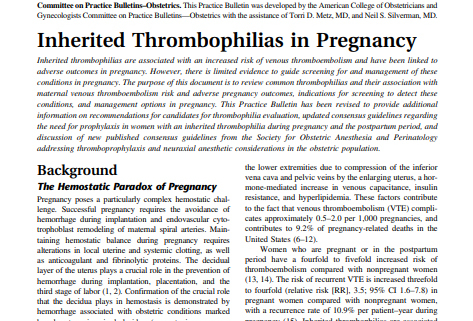INHERITED THROMBOPHILIAS IN PREGNANCY
Inherited thrombophilias are associated with an increased risk of venous thromboembolism and have been linked to adverse outcomes in pregnancy. However, there is limited evidence to guide screening for and management of these conditions in pregnancy. The purpose of this document is to review common thrombophilias and their association with maternal venous thromboembolism risk and adverse pregnancy outcomes, indications for screening to detect these conditions, and management options in pregnancy. This Practice Bulletin has been revised to provide additional information on recommendations for candidates for thrombophilia evaluation, updated consensus guidelines regarding the need for prophylaxis in women with an inherited thrombophilia during pregnancy and the postpartum period, and discussion of new published consensus guidelines from the Society for Obstetric Anesthesia and Perinatology addressing thromboprophylaxis and neuraxial anesthetic considerations in the obstetric population.
Background
The Hemostatic Paradox of Pregnancy Pregnancy poses a particularly complex hemostatic challenge. Successful pregnancy requires the avoidance of hemorrhage during implantation and endovascular cytotrophoblast remodeling of maternal spiral arteries. Maintaining hemostatic balance during pregnancy requires alterations in local uterine and systemic clotting, as well as anticoagulant and fibrinolytic proteins. The decidual layer of the uterus plays a crucial role in the prevention of hemorrhage during implantation, placentation, and the third stage of labor (1, 2). Confirmation of the crucial role that the decidua plays in hemostasis is demonstrated by hemorrhage associated with obstetric conditions marked by absent or impaired decidua (eg, ectopic pregnancy and placenta accreta). Conversely, decidual tissue factor also can promote the intense hypofibrinogenemia and disseminated intravascular coagulation observed in decidual hemorrhage (ie, placental abruption).



